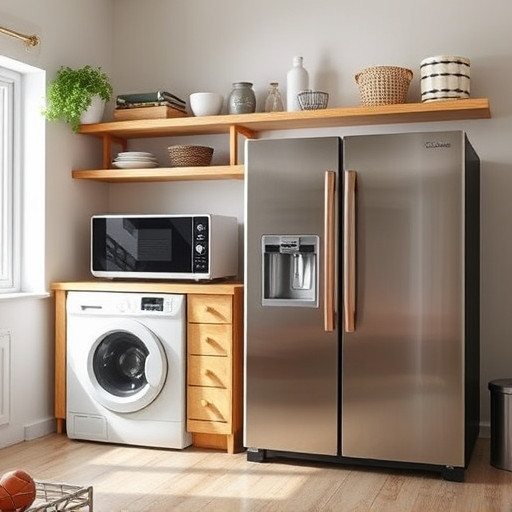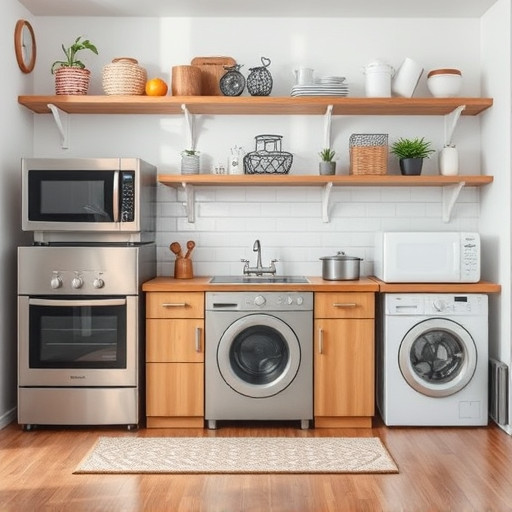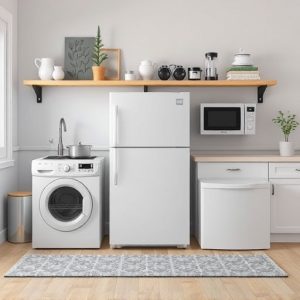When installing new major appliances such as ovens and ranges, it is imperative to follow the manufacturer's specific installation manual for your model to ensure safety and proper functioning. For both gas and electric models, correct placement and ventilation are essential to prevent hazards like fume accumulation or overloaded circuits. Safety clearances must be observed around all sides of the appliance, with at least three inches of space above the range for ventilation and heat circulation. Professional installation by licensed experts is highly recommended for gas or electric connections to adhere to safety standards and legal requirements. After installation, regular maintenance checks are crucial for identifying issues early, maintaining efficiency, and ensuring long-term safe operation of your major appliances in the kitchen. Adhering to these guidelines not only extends the lifespan of your appliances but also ensures that they operate at their best, providing consistent, safe cooking experiences.
When it comes to major appliances, ovens and ranges are central to our daily lives, enabling us to prepare meals safely and efficiently. Whether you’re installing a new unit or addressing repairs, the stakes are high for both functionality and safety. This comprehensive guide covers best practices for oven and range installation to ensure your appliance operates at its peak performance while minimizing risks. From understanding the critical role of proper installation to leveling, connecting power and gas, and adhering to manufacturer instructions, each step is crucial for a safe cooking environment. Furthermore, recognizing when professional assistance is necessary can save you from potential hazards.
For those encountering issues, this article also delves into troubleshooting common repair problems, offering insights into self-diagnosis and basic repairs. From electrical failures to thermal concerns, each potential malfunction is addressed with clear, step-by-step guidance. Regular maintenance tips are provided to prevent future complications, ensuring your oven or range remains a reliable cornerstone in your kitchen. With a focus on safety and longevity of your major appliances, this article equips you with the knowledge for effective installation and repair.
Best Practices for Installing Your New Oven and Range

When installing your new oven and range, adherence to best practices is paramount for both safety and longevity of the appliances. Begin by carefully reading the manufacturer’s installation manual specific to your model. This document will provide detailed instructions and safety guidelines tailored to your oven and range. Ensure that the installation site is in a well-ventilated area to prevent the accumulation of fumes and combustion products, which is crucial for gas models. For electric models, check that the outlet can handle the power requirements of the appliance to avoid overloading circuits.
Proper placement is also key; your oven and range should be situated in a location that allows for ample clearance around all sides to prevent any fire hazards or interference with operation. Additionally, ensure that there is at least three inches of space above the range for proper ventilation and heat circulation. When connecting to gas or electricity, only use licensed professionals to avoid any risks associated with improper connections. They will also be able to inspect the installation to confirm it meets local codes and regulations. Regular maintenance checks after installation can help identify potential issues early on, ensuring your major appliances operate efficiently and safely for years to come.

When it comes to ensuring safe and efficient cooking within your household, proper installation and regular repair of ovens and ranges are paramount. Major appliances such as these require precise handling due to their integral role in kitchen operations. Proper installation involves aligning the appliance according to manufacturer specifications, which includes checking for adequate clearance around the oven or range to prevent combustion risks and ensure optimal performance. It’s crucial to secure the appliance firmly to prevent any form of movement during operation to avoid accidents or damage. Additionally, connecting the power supply and gas lines—if applicable—should only be done by a qualified professional to adhere to safety standards and building codes.
Regular repair and maintenance are equally important for maintaining the longevity and efficacy of your oven or range. Identifying minor issues before they escalate into larger problems can save time, money, and potential hazards. Whether it’s a faulty control board, an unreliable thermostat, or a malfunctioning heating element, timely repairs by certified technicians will keep your major appliances running smoothly. Regular cleaning and inspection can further extend the life of your oven or range, ensuring that it operates safely and efficiently, thereby providing you with reliable cooking performance for years to come.
When integrating a new oven or range into your kitchen, safety and efficiency are paramount. Following the best practices for installation as outlined ensures your major appliances operate at peak performance while minimizing risks. For repairs, it’s always advisable to consult professional services to address any issues promptly and correctly. By adhering to these guidelines, you can maintain a safe and functional cooking environment. Remember to treat your kitchen major appliances with care for sustained use and satisfaction.
